The country of Sudan has never graced my travel “bucket list,” not once. In fact, if I had to list all countries that I still would like to visit in numerical order, Sudan would likely have been in the bottom five percent. So why on earth did I spend a week there?
When I went online shopping for an overland trip that covered all the highlights I wanted to visit in Ethiopia, I found one that offered a “side trip” of sorts, looping through Sudan. I could add it on for not much more money, and since I was using Frequent Flyer miles, airfare would not be any different. So why not see what was there?
Now, as I sit here in Addis Ababa, having just completed the 30 day trip, I look back on all the phenomenal sites I have seen since I left DFW on New Years Eve, and Sudan definitely stands out as a highlight. I have much to share, but I will start with the many contrasts of the capital city of Khartoum.
After three flights from Dallas to Istanbul by way of Houston, then on to Khartoum Airport, I arrived in the middle of the night. I would be less than honest if I didn’t admit to being just a little scared out of my wits. Sudan is a “cardless destination” for us western citizens. ATMs only accept local Sudanese cards, and credit cards are not accepted. So on different parts of my body, in my backpack, and my luggage was hidden more cash than I want to think about. I had applied for “visa on arrival,” so I had to pay for my Sudanese visa fees, pay my “fixer” who would meet me at the airport and escort me through the process, then bring me to my hotel, all to be paid in cash. Then there was the “kitty” payment for both the Sudan loop and the Ethiopia loop (a portion of the tour cost which must be paid in local currency, such as camping fees, restaurants, attraction admission, etc.) I also had a month’s worth of spending money, and an “Emergency fund,” all hidden away on my person. I don’t know if I could have been more nervous had I been wearing a suicide vest.
But upon arrival, the young, kind, neatly dressed, well educated, interesting young man, Wileete, who met me at my flight in the middle of the night, put me at ease. We talked constantly while waiting on my Visa to be processed and my luggage to arrive. I learned more in that hour on Sudanese relations with the US than what little research I’d had time to do during the busy Christmas holiday. I am ashamed to admit, I didn’t even realize at the time that Sudan was under US sanctions. Wileete told me he had tried 13 times to apply for a Visa to come to the US, and he wasn’t going to give up. It makes me sad to think that Sudan is now one of the latest victims of trump’s “travel ban” expansion, so Wileete has got a quite a wait in front of him.

My plush hotel room in Khartoum…$75 per night, cash payment only.
Moustaffa, the front desk supervisor was equally kind, even going so far as to walk me down the street and wait with me while I got my Sudan SIM chip working in my phone. He told me I was safe to walk down any street in Khartoum. “We are Muslim here, and we believe God will punish is if we do wrong. So no harm will come to you in Sudan. But when you get to Ethiopia, watch out for those Christians!” (I have to say after now having spent 30 days in both countries, my “spidey senses” would agree with his assessment.)
Khartoum was an experience in contrasts, as continually, things were not as they first appeared. While the country is in Africa, it feels much more like the Middle East. The ink-black faces seemed so menacing and foreboding. But all one had to do was crack a smile, and instantly, their faces lit up with a beaming smile in return, with an enthusiastic “Salam!” Arabic greeting.
Most men wore the traditional long white flowing robes that remained spotless…almost “blue-white” they were so clean. Yet they managed to stay clean while walking through the filthiest streets I can recall seeing, lined with garbage. I’ve never seen cleaner clothed people, or conversely, a city with more litter.
Infrastructure offered up contrasts as well, as I would check Google Maps to see what looked to be a main thoroughfare through the city, only to arrive and find it was a narrow dirt path. And as one of the largest exporting oil countries with 70 to 90% of their exports being in oil, petrol lines were so long, they wound around in a labyrinth. And stranger still, our white faces got us cuts in line.
Having arrived a couple of days early to acclimate to the time change before the tour began, I met a couple of my fellow travelers before the official start date. We organized a day tour with a taxi to take us to see the sights of Khartoum. We would be with our driver from 8:30am until 6pm, for a cost of 3,000 Sudanese Pounds, split three ways, the equivalent of twenty bucks each for a full day tour. Here are the scenes from that day tour:

First stop on our Khartoum day tour was the camel market, about 20 minutes outside of town.
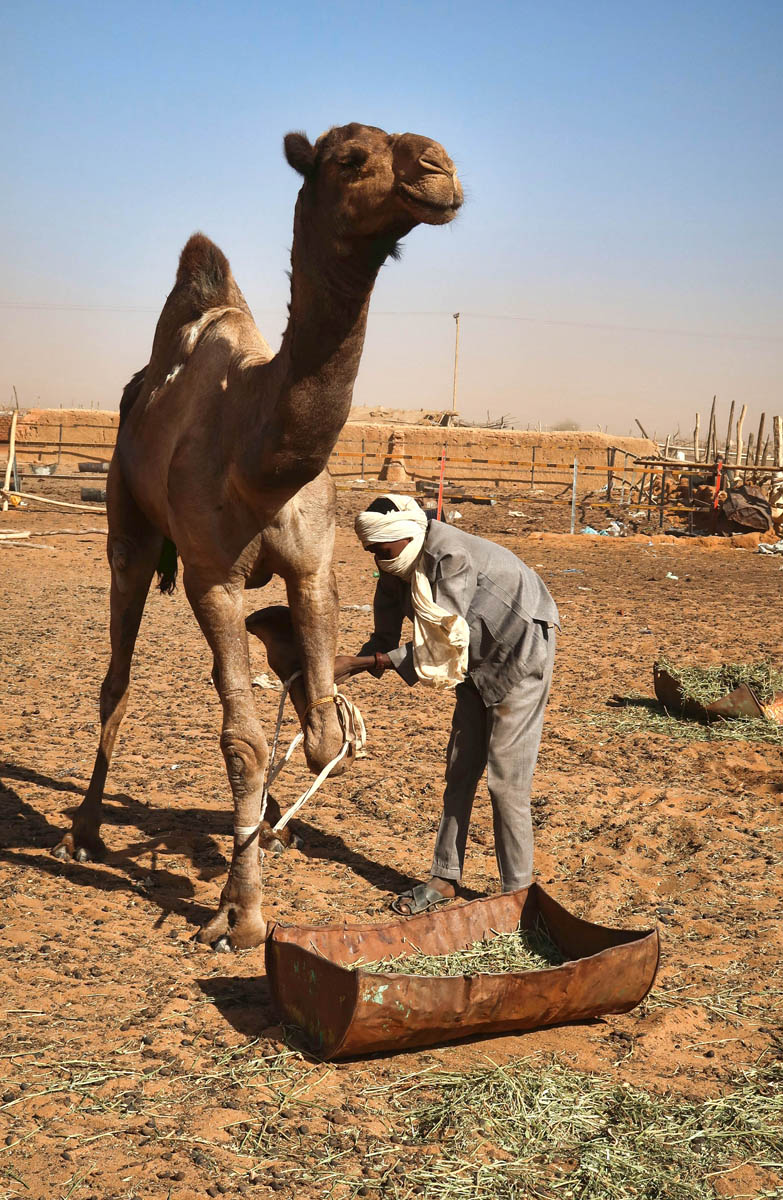
Not a pleasant place for animal rights activists, as camels and donkeys have their feet tied together, or in this case, have one leg tied up to keep them from wandering away.

Some interesting looking cattle, as well as goats at the Camel Market.

Here is an example of some threatening-looking faces. But break the ice by asking them about their solar panel…

And not only are they eager to show us their phone charging station, they ask us if we would like to plug in our own phones.
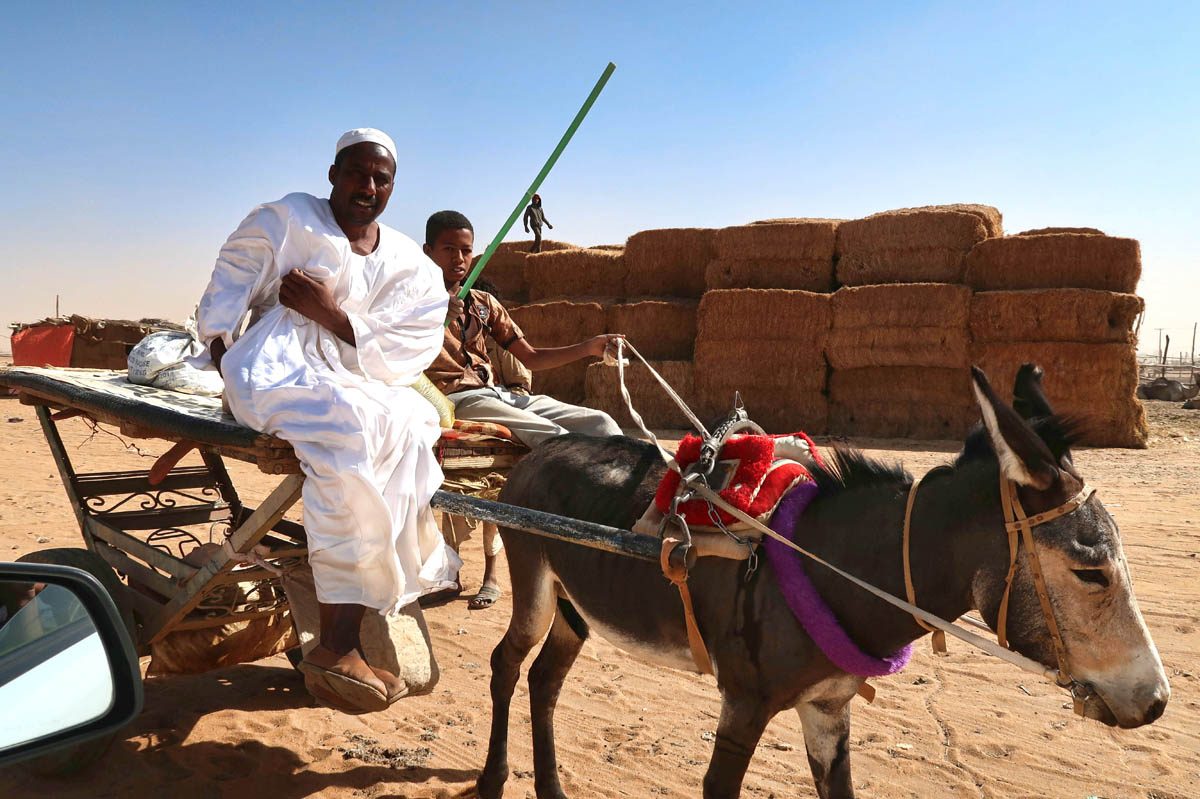
People are extremely friendly, some even asking to have their photos taken so they can review the photo in the display.

Mahdi’s rocket-topped tomb which has been restored after it was destroyed by British General Kitchener.

A lively trio is providing entertainment on the grounds of the tomb.

Most places don’t have running water, so these giant clay pots are located along the streets as a source of drinking water.
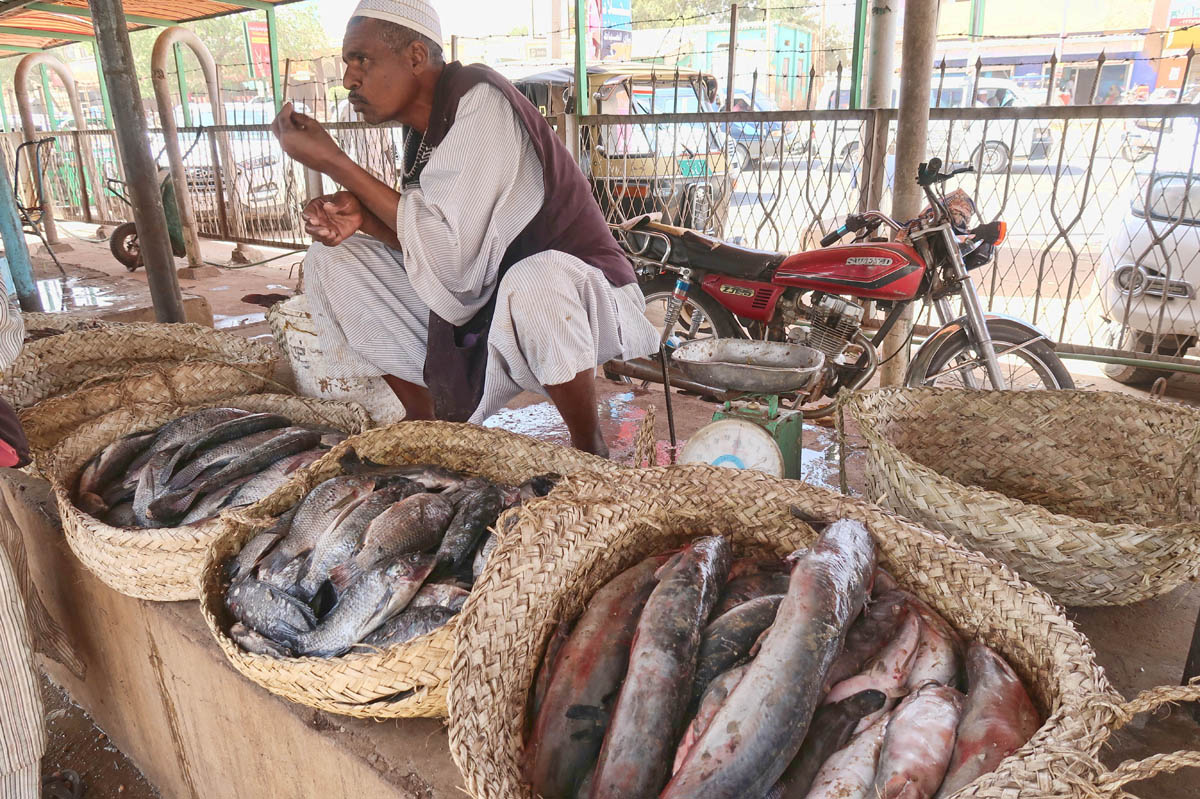
An optional stop on the tour was the Fish Market. Of the three of us, two of us wanted to stop, so the third woman with a weak stomach waited in the taxi. She missed quite an experience!

Ice is in scarce supply in the fish market, but the fish (Nile River fish) appear to be relatively fresh,

Not for the faint of heart is the back area of the fish market where fish are gutted and cleaned. Note basket of skinned fish heads in the foreground.

Fishmonger prepares to filet large fish.

I believe these to be dried cherries for sale. I was offered a sample, but chickened out.

All the “fixings” for preparing fish, including garlic and onion, salt, spices, and limes.

Next stop on the tour was the famous local Omdurman market, which contains a labyrinth of narrow streets selling crafts, antiques, spices, and all manner of flea market offerings.

Lots of leather slippers for sale along this area.

Lots of exotic skins for sale in the crafts section. No frog purses here, but I did find a nice crocodile head accessorized bag (Rhonda, if you are reading, this one’s for you.) 😉

Some nice exotic skins for your Vespa ride…
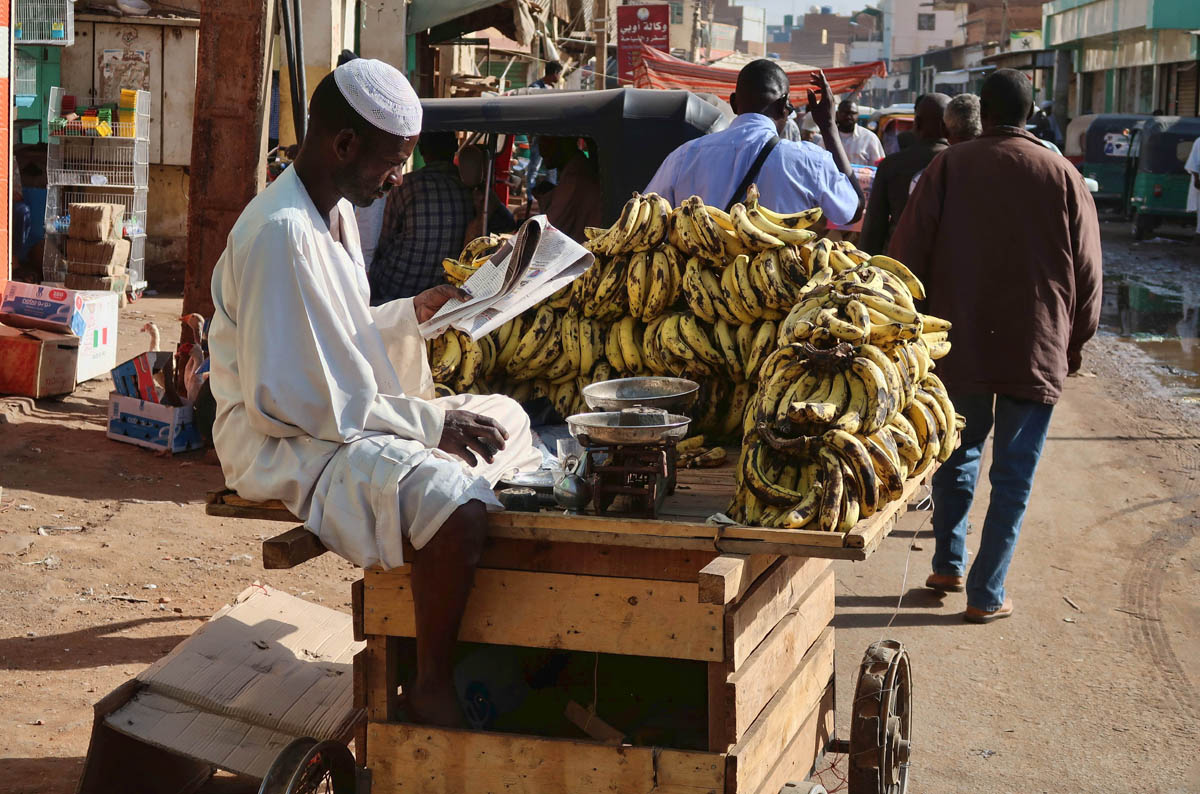
Bananas are sold in abundance in all of Sudan.

Spice section of the Omdurman market. Very aromatic!

Last stop on our day tour was to see the “Whirling Dervishes” at the Hamed al Nil mosque. This ceremony only takes place on Friday evenings from 4:00pm to sundown, and the locals come pouring in from all directions as if it were a football game.
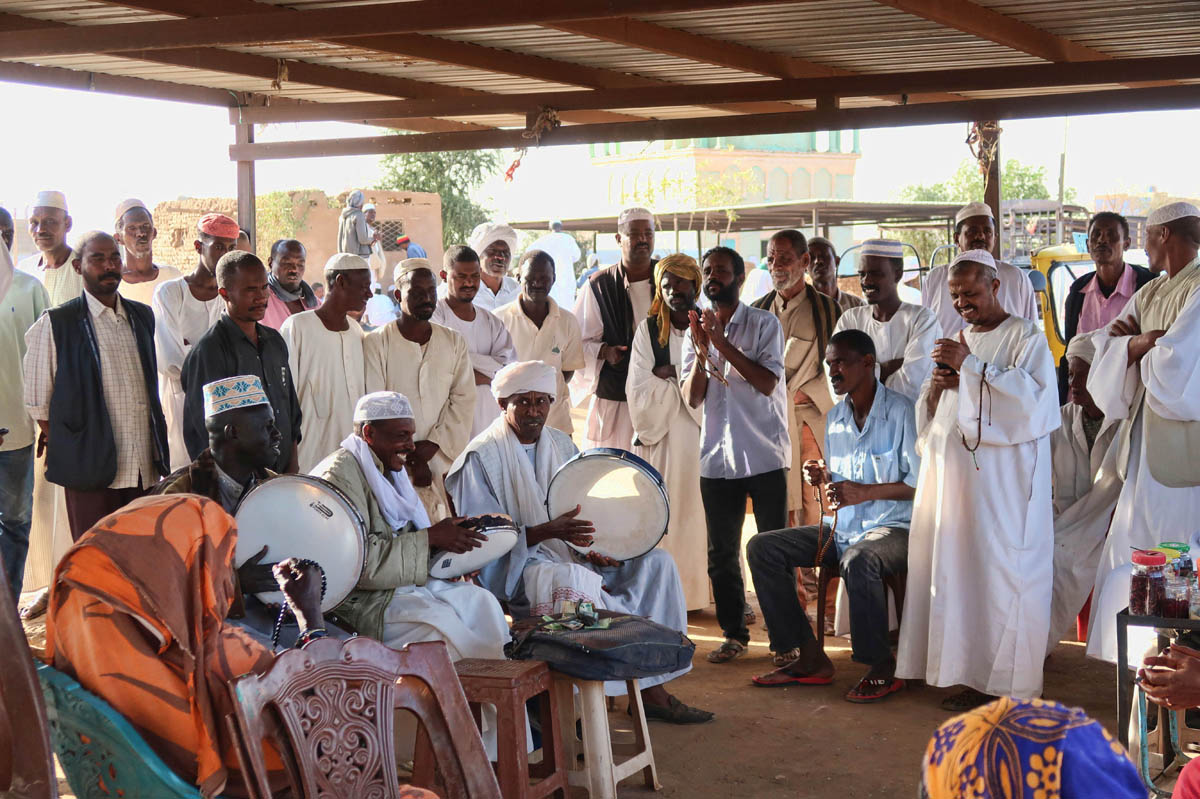
Early on, there are lots of locals having picnics around this chanting ensemble.

The mosque is located in the middle of a cemetery, where paths weave through the gravesites.

While these are Sufi muslims, they do not wear the long white robes like Turkish Sufi, but rather brightly colored robes.

Some of them look quite comical.

While they are referred to as “whirling,” it’s really more like “circling” as this group of men circles around and around a light pole, chanting and drumming, going faster and faster.
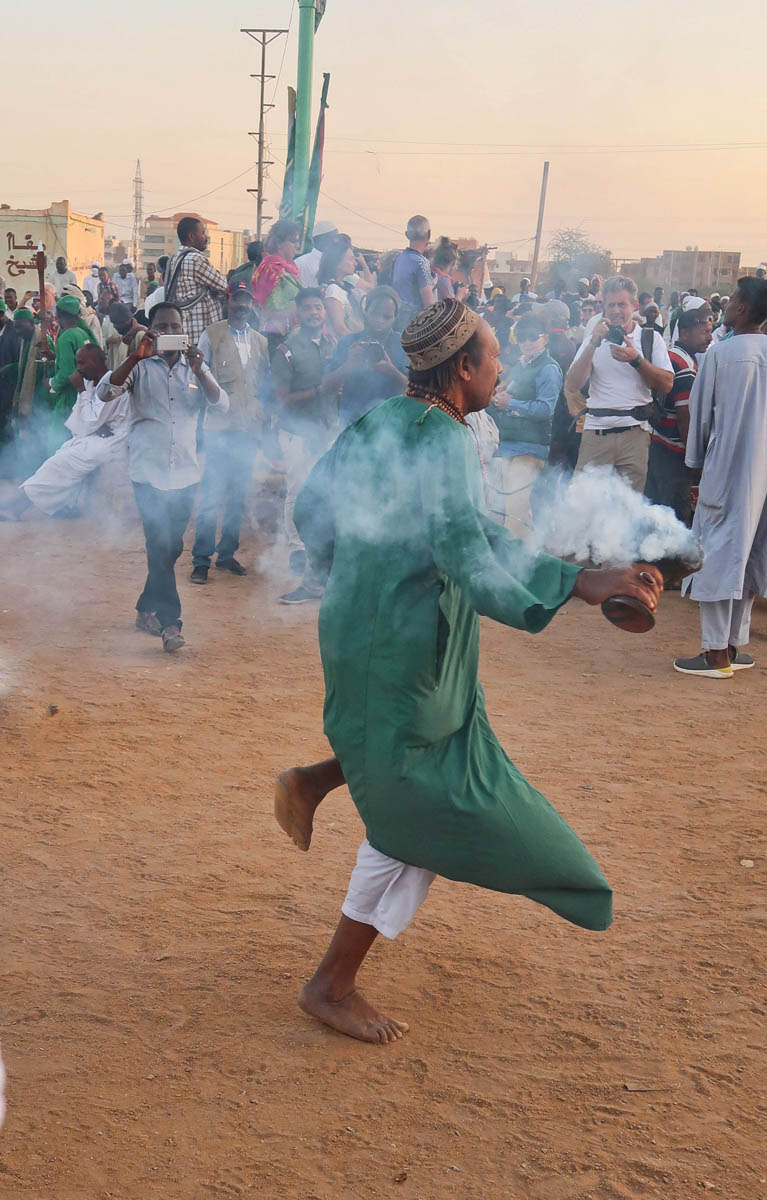
This incense burning man was the only one I saw actually “whirling.”

And then, the minute the sun goes down, the show is over. They all scatter to go pray.

The next day, we organized a boat trip to the confluence where the two tributaries of the Nile River, the White Nile and Blue Nile converge at the point on the left.

If you look at the water in the distance, you will see the different colors of the Blue versus White Niles, colored by clay.

The big egg-shaped building is the five star Corinthia Hotel, referred to as “Gaddafi’s Egg” because it was funded by the Libyan government

One of many boats that make the trip across the Nile to Tuti Island, a popular spot for (fully clothed) bathers.

Sudan National Museum. Some interesting temple artifacts, but don’t allow much more than an hour.
Next up, the official tour leaves the capital city of Khartoum, and begins a loop around Sudan.

Wow! So interesting! Once again, thank you for sharing your travels!
Amazing! Who knew? and for the last 6 weeks, Marti and I have been wondering just what happened to you in the wilds and dangers of Sudan. We are very happy you are safe and had a wonderful time there. Can’t wait to hear more.
Oh, Suzanne…beautiful and amazing. Parts of this made me cry. As always, you inspire me. Can I take a trip with you.
Linda, it would be my honor. You have been on my mind a lot. Sorry I have not been able to check in to see how you are doing, but internet has been impossible. I hope you are doing okay…
Brilliant! Can’t wait for the next installment.
I can’t wait either! and Suzanne, I note that women and kids are missing in your people-shots, and that’s very typical of a Muslim country. I guess the women and kids are hiding in the rivers washing their menfolk’s white robes 🙂
Such pageantry and color…beyond the “ink” black faces and blue-white robes.
Nice!
Very very interesting, and a different perspective. Looking forward to the rest.
I have to admit, I enjoyed saying , “Suzanne’s in Sudan”! And I agree with others comments; interesting post & looking forward to the next chapter.
So what were the temps like? And the food?
I have to laugh, as that was the subject line of the first email I was able to send home from Khartoum to the family. “Suzanne’s in Sudan.” haha!
Temps were much cooler than I had anticipated. Short-sleeves in the daytime, but once the sun went down, I needed a jacket! I was expecting “Hot, Hot, Africa Hot!” so I took lots of lightweight clothing, but I should have packed a few more sleeves!
As for food, well, there really are no “tourist accommodations” outside of Khartoum, so the only food available is from roadside shacks (more on the fate of eating in these to come.) The main staple is “ful,” which is mashed beans. Unlike my mother, I am not a fan of beans, so I bought a lot of potato chips and tea biscuits. 😉 But we also cooked our own meals from the truck. So while grocery shopping in the markets was often a challenge, we managed to do okay!
Wow! Serious ovaries, girl!!
Were the “whirlers” Sufi?
Hi, Roxanne! Nice to hear from you. Yes, they were Sufi Muslims, though not as “uniformly dressed” or tidy as the Sufis in Turkey. More fun, though. haha!
What incredible adventures! Love your photos and captions. Thanks for sharing all this. You remind me of this quote: “Twenty years from now you will be more disappointed by the things that you didn’t do than by the ones you did do. So throw off the bowlines. Sail away from the safe harbor. Catch the trade winds in your sails. Explore. Dream. Discover.”― Mark Twain
Thanks, Amiga, for just being you and sharing all that.
Wow, your postings are never boring! What an adventure!
A place that I have never considered visiting. So far quite interesting. I share your apprehensions about carrying cash, but it sounds safer than going to Boston. Looking forward to the rest of this adventure.
allen
Ha! Absolutely, yes! I MUST have that crocodile bag! Oh, you! Youuuuuu! You tease me so with those exotic accessories! Now I have *two* hard-to-get-to destinations in order to complete this world wide scavenger hunt. What a grand first two days of your month long journey…the sights, sounds, smells (that fish market is the bomb!). How I wish you’d consider being my “fixer”, Suzanne; I would pay handsomely for you to whisk me off to an amazing destination, seeing to it I don’t die in the journey! Can’t wait for more, more, more of this tres cool trip you are on! 🙂